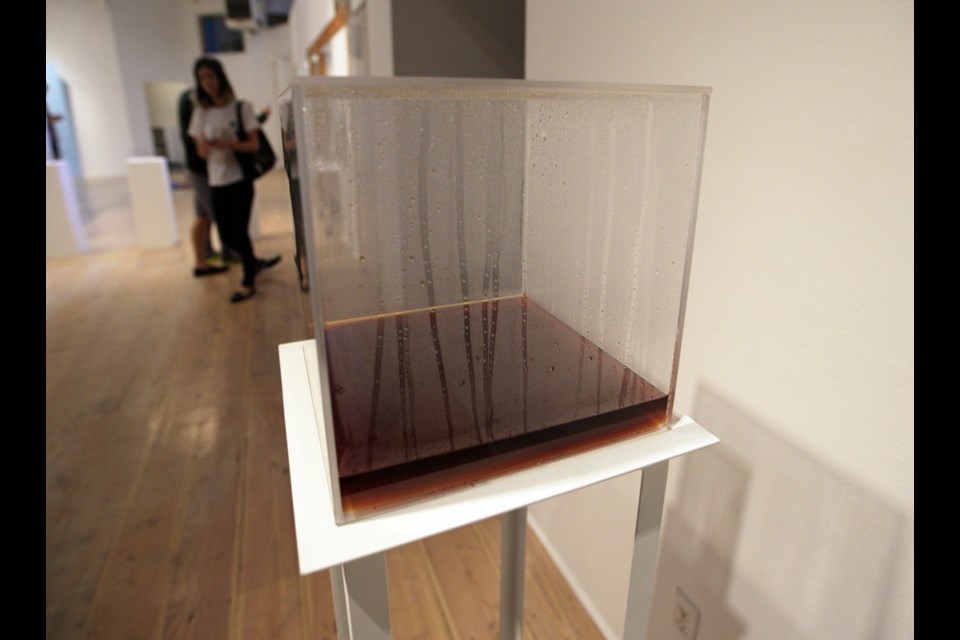 Anybody here remember Minimalism? There was the long project of Modernism: from Impressionism to Expressionism, through Abstract Expressionism to Colour Field and Hard Edge. And, when there was hardly a trace of the artist left, we were offered Minimalism.
Anybody here remember Minimalism? There was the long project of Modernism: from Impressionism to Expressionism, through Abstract Expressionism to Colour Field and Hard Edge. And, when there was hardly a trace of the artist left, we were offered Minimalism.
“It is also known for being anti-humanist in its attempted removal of the artist’s hand, and in its apparently emotionless intellectualism,” says John Hampton. And he ought to know — he is the curator of the show titled Why Can’t Minimal? on now at Open Space Gallery (510 Fort St., 250-383-8833, until Oct. 22).
I remember Minimalism. As a student I stood before Donald Judd’s set of seven galvanized iron boxes, bolted onto the wall at the Art Gallery of Ontario. It was appropriately titled Untitled, and I found it … perfectly boring.
My art-history textbook explained: “Judd vehemently insists that primary structures or minimal sculpture — most specifically his own — constitutes a direction essentially different from earlier constructivism. The difference, as he sees it, lies in his search for an absolute unity or wholeness through repetition of identical units in absolute symmetry.” Yawn.
Judd seems to be a pompous emperor of art, long overdue for a new set of clothes, and this exhibit sets out to take the measure of him and his cohorts. Sent on tour by the Art Museum of the University of Toronto, this show presents 13 exhibits that refer specifically to creations by the masters of Minimalism: Daniel Buren, John McCracken, Carl Andre, Hans Haacke.
I confess that those names aren’t really on the tip of my tongue. Anyway, none of those famous artists are in the show. It’s actually a gathering of young artists from Toronto riffing on the old guys, joking them up a bit.
Like this: John Boyle-Singfield took as his inspiration Haacke’s proto-minimalist Condensation Cube. About 40 or 50 years ago, Haacke sealed a small amount of water in a Plexiglas cube to make visible the circulatory systems that connect the interior with the exterior of the art object — condensation formed on the inside of the box!
And now, Boyle-Singfield’s recreation uses Coke Zero instead of water. (The catalogue helpfully defines Coke Zero as a “hyper-contemporary and commodified version of nothingness.”) So there you have it: a 12-inch-square cube containing approximately three litres of Coke Zero, some of it condensing into droplets. Is it an homage? A remix? A joke?
Here’s another one. Tammi Campbell made an impressive copy of a shaped canvas by Frank Stella, and titled it Pre Post-Painterly (After Stella). It’s 46 feet 8 inches long and four feet high. Stella’s original hard-edge acrylic was done with masking tape and paint rollers, new materials that made this type of painting possible.
In writing about Stella and his big thing in the pamphlet, Hampton notes: “Minimalism has had, and continues to have, a gender problem.” He goes on to enumerate some traits of minimalism that are associated with masculinity: “rigidity, rationalism, professionalism, seriousness.”
No wonder Campbell took such delight in constructing her own Stella, correct in every detail, but without the paint. It’s just the masking tape, put down and left in place. The emperor’s underclothes, you might say.
All this sent me to my dictionary to look up something. “Irony: a figure of speech in which the intended meaning is the opposite of that expressed by the words used, usually taking the form of sarcasm or ridicule in which laudatory expressions are used to imply condemnation or contempt.”
The subtle tape-striped panel Campbell made looks like respect, but if you are in the know, it’s mockery. Is Minimalism worth mocking? Does anyone remember?
Hampton’s little handbook is helpful. It brings up Robert Garnett’s definition of something he calls Abstract Humour: “not necessarily a laughing matter, it is more like being put in a ‘funny or preposterous’ situation, like that of a critic encountering a work of art that seems to disable one’s prior criteria for the success or failure of a work of art.” Perhaps this “disabling of one’s criteria” is what people go to art galleries for these days.
The Toronto artists are not here just to ridicule. Some people love this Minimalist stuff. Hampton confesses that, “like any reasonable being, I do enjoy spending hours in front of a Sol LeWitt sculpture.” He explains that the artists in his show are using paradoxical propositions “to articulate new and playful ways of activating minimal art.” Since Minimalism was rigid at birth, and has been long dead for all practical purposes, it certainly could use some activating.
So how does one activate that boring minimalist Donald Judd? John Marriott’s collage is only a sheet of computer paper with a few images printed on it, and off to the left he included a photo of the very Untitled piece I saw in Toronto years ago. In addition to Judd’s stairway of boxes, there is a picture of a cubic sculpture by Sol LeWitt and a photograph of a chimpanzee taking part in a psychological experiment. The chimp is climbing over a bunch of boxes to get at a banana. And it’s not just any banana he’s after, but the banana on the Velvet Underground record cover by … Andy Warhol.
Get it?



